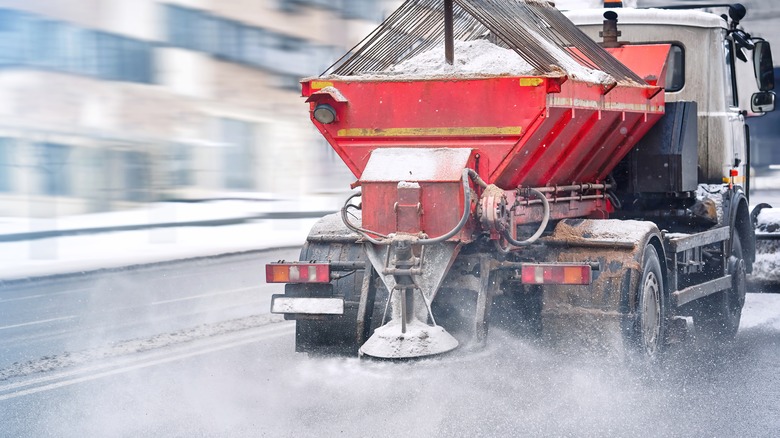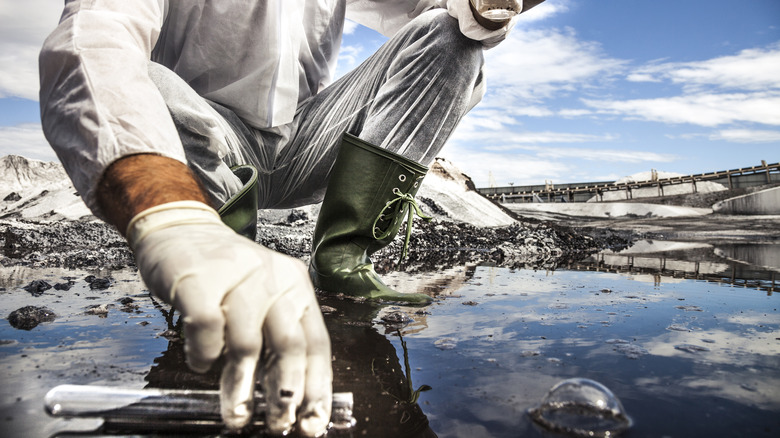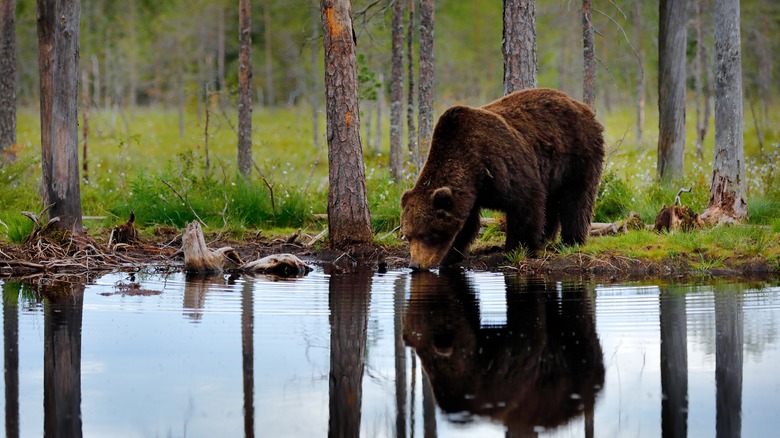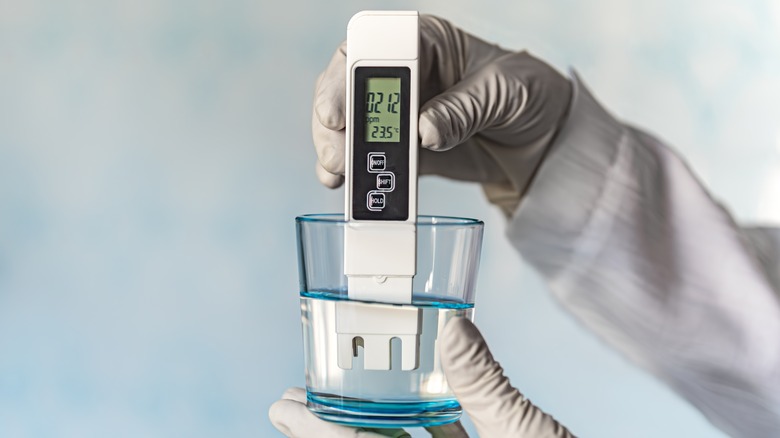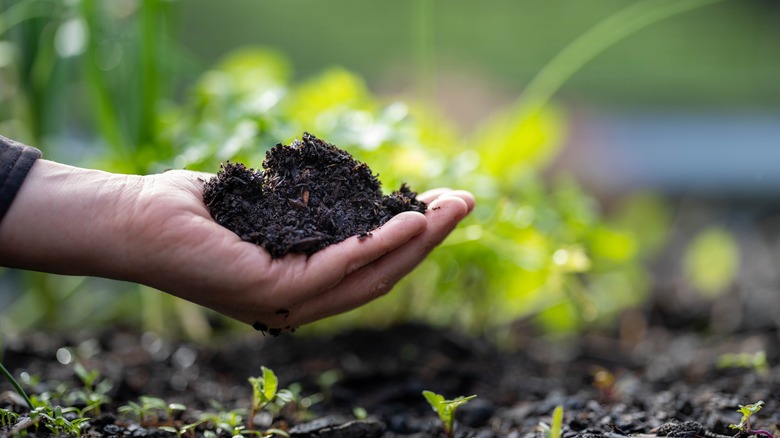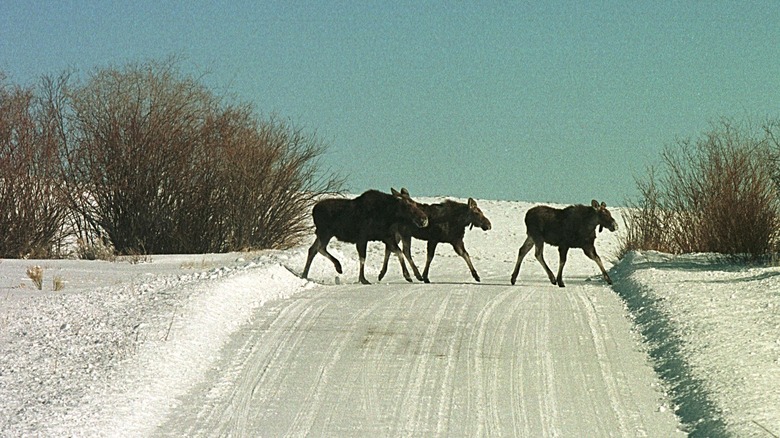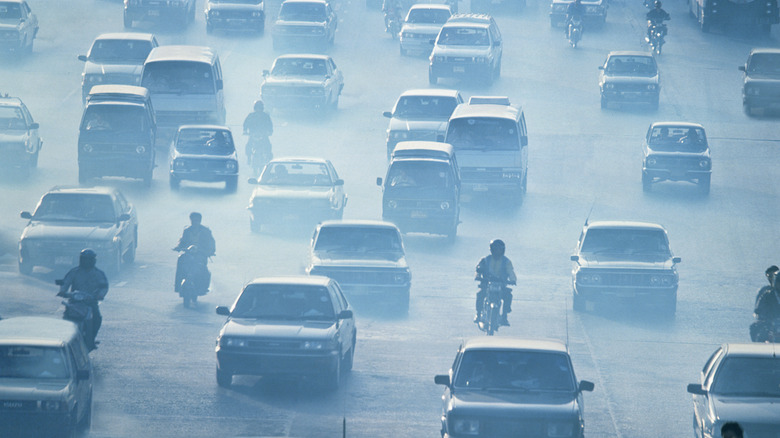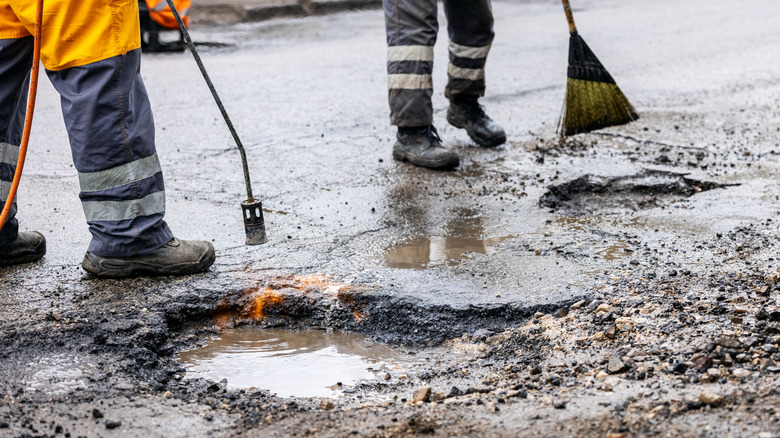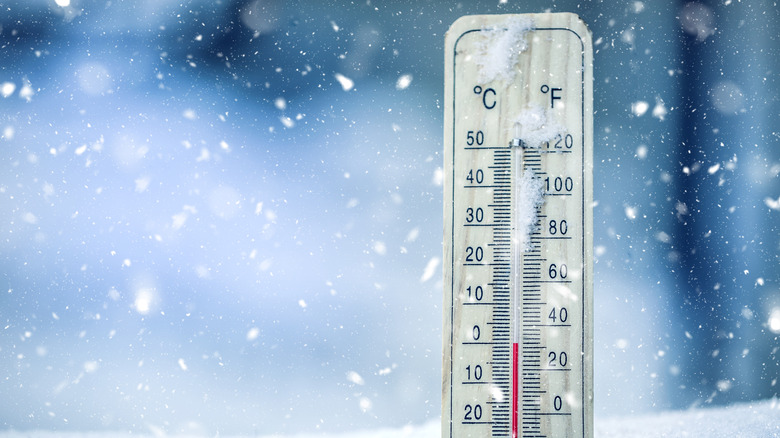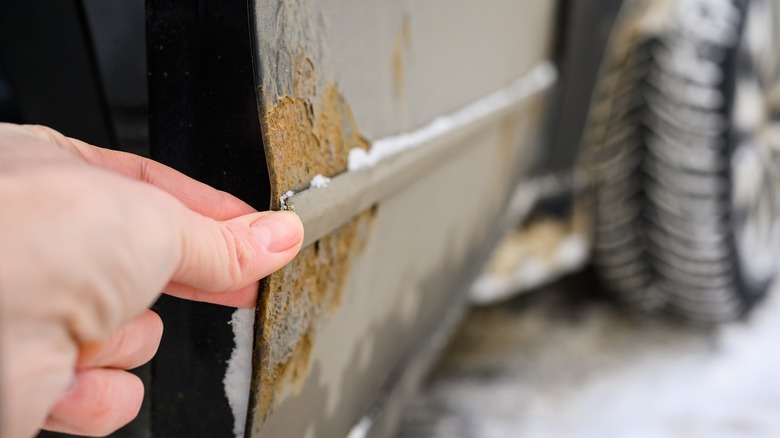10 Reasons Why Road Salt For Winter Ice Is A Terrible Idea
Winter brings its own set of challenges, and for many regions, road salt has been the go-to solution for icy roads. It's almost a winter ritual — as temperatures drop, trucks laden with rock salt drive through the streets, scattering salt to keep us safe on the road. However, this seemingly benevolent act of winter preparedness comes at a hidden, unsuspectingly staggering cost.
Beneath the surface of this salty precaution lies a myriad of issues impacting our health, environment, and economy. From the dangerous air pollution caused by salt dust to the corrosion eating away at our vehicles and vital infrastructure, the impacts are far-reaching and profound. This article delves into these often-overlooked consequences, shedding light on why road salt, while effective in ensuring immediate road safety, poses significant long-term challenges.
With annual damages to infrastructure and vehicles running into billions of dollars, the necessity for more sustainable and environmentally friendly alternatives has never been clearer. As we explore these challenges, ranging from the ineffective nature of salt in extreme cold to its role in escalating maintenance and repair costs, we find a complex web of issues begging for attention.
This is not just a story about keeping roads ice-free; it's a wake-up call to reassess a practice that's as old as modern winter road maintenance itself.
Here are 10 reasons why road salt for winter is a terrible idea.
Environmental water pollution
Since the 1940s, road salt has been a popular choice for deicing in the United States, with states like Pennsylvania using an average of 801,453 tons annually. However, the aftermath is problematic, causing a significant increase in salinity levels in freshwater ecosystems. This shift has been observed across the United States, where 37% of drainage areas have experienced a rise in salinity over the past 50 years, primarily due to road salt in colder regions.
A study by the US Geological Survey (USGS) further highlights the impact, revealing that 84% of urban streams have seen an increase in chloride levels, directly attributed to road salt. Shockingly, 29% of these streams have spiked to levels unsafe for drinking during winter months. The high chloride content is toxic, and poses a threat to fish, insects, amphibians, and plants, significantly disrupting ecosystems. It's not just surface water that's at risk; groundwater sources, too, are affected, with more than half of the sampled private drinking water wells in East Fishkill, New York, exceeding EPA health standards for sodium.
Efforts by departments like PennDOT to limit salt usage and mix sand for improved traction are steps in the right direction, but these are not sufficient. Over-salting by private entities contributes significantly to this environmental challenge. This situation calls for a more environmentally conscious approach to winter road safety, balancing the need for ice-free roads with preserving vital freshwater ecosystems.
Harmful to wildlife
The use of road salt during winter, primarily sodium chloride, has severe repercussions on wildlife, echoing across various ecosystems. Road salt runoff tends to sink to the bottom of lakes and streams, forming a dense layer that hinders gas exchange with the overlying water. This can lead to oxygen depletion, which is detrimental to aquatic organisms. For instance, Mirror Lake in New York's Adirondack Park has struggled with dissolved oxygen issues due to high salt content.
The adverse effects on aquatic life are evident. Freshwater fish struggle to survive in overly saline waters, while eggs and larvae of various species, including mussels, die due to high salinity. Similarly, amphibians like frogs and turtles face infection when exposed to excessive salt concentrations in lakes and rivers. The alteration in ecosystem dynamics has even led to the survival of salt-water species like blue crabs in Ontario lakes and rivers, an unnatural occurrence caused by salt accumulation.
Salt doesn't simply vanish with the melting snow but accumulates in water bodies, causing long-term harm to freshwater wildlife. This accumulation calls for urgent action to mitigate the damage and protect the diverse range of species dependent on these ecosystems.
Contamination of drinking water
Annually, around 25 million metric tons of sodium chloride, similar to table salt, are used across the US for deicing roads. This excessive use has tripled over the past 45 years and has led to increased salt concentrations in freshwater sources. Research reveals that these salts not only harm ecosystems but also contaminate drinking water, mobilizing dangerous chemicals like radon, mercury, and lead.
In Flint, Michigan, for example, high chloride levels in water due to road salt usage contributed to the release of lead from pipes. Homes near roads, particularly in lower areas or downhill from highways, often have elevated levels of deicing salts in their wells.
Studies in the Philadelphia region show that sodium levels in drinking water sometimes exceed healthy limits for people on salt-restricted diets, with concentrations occasionally reaching 6.4 times the EPA's guideline for such individuals. These concerns highlight the need for more sustainable deicing practices and better public awareness regarding the impact of road salt on water quality.
Soil degradation
When sodium and chloride ions from dissolved road salts infiltrate the soil, they displace vital minerals such as potassium, phosphorus, and especially magnesium and calcium. This displacement results in nutritional deficiencies for plants. Chloride ions transported to leaves hinder essential processes like photosynthesis and chlorophyll production, potentially reaching toxic levels that cause leaf burn and dieback. The impact is not immediate but can manifest during hot, dry weather or even years later.
In addition to nutrient displacement, sodium ions affect the soil's physical structure. They can increase compaction, thereby reducing drainage and aeration. This change can lead to "physiological drought," where plants suffer from water stress and root dehydration despite sufficient soil moisture.
Road salt usage also leads to increased soil pH, further stressing plants. Particularly in urban areas, elevated pH levels can arise from various factors, including the weathering of construction materials and pollution. However, the alkalization of soil due to road salt is significant. Higher pH levels limit the availability of critical nutrients and disrupt key microbial processes essential for plant health.
The widespread application of road salt not only poses risks to water quality and wildlife but also significantly degrades soil health, impacting plant growth and ecosystem stability. The consequences of such degradation call for more sustainable road deicing methods and careful consideration of planting vegetation near roadsides.
Safety hazards
The application of road salt, essential for winter safety, introduces various hazards beyond its immediate purpose. The brine created by road salt can easily be tracked into homes and businesses. This often unnoticed transfer results in slippery and potentially dangerous indoor surfaces, increasing the risk of slips and falls.
Road salt can also threaten the health and safety of household pets. The salt can irritate their paws, get into open wounds, and cause them pain. Also, if dogs lick their paws to get rid of the salt, they risk ingesting harmful chemicals that are found in many ice melters. This can lead to serious health issues like nausea, vomiting, and in severe cases, liver damage or seizures.
Another significant concern is wildlife attraction to road salt. Research shows that wild animals such as moose and deer are drawn to salt-covered roads. This behavior brings them closer to high-speed traffic, heightening the risk of vehicle collisions. These kinds of accidents not only pose a danger to the animals but also to drivers and passengers. A study conducted by Roy Rea, a biology and forestry instructor, found that areas with roadside salt accumulations were popular with moose, leading to frequent, sometimes fatal, collisions. Out of 30 locations of moose-vehicle accidents, nine were near salt licks.
Human health risks
Road salt can also be risky to the health of humans in areas where it's heavily used. The environmental contamination, as discussed earlier, has far-reaching consequences. As the road salt dissolves, the mixture releases sodium and chloride ions that leach into the soil and water, elevating sodium levels in nearby farming areas and water sources. When humans drink local water, they are unknowingly contributing to increased dietary sodium intake.
Excessive sodium in the bloodstream can cause high blood pressure, heart disease, and stroke. According to the Centers for Disease Control (CDC), the majority of Americans eat too much salt in their diets anyway, with road salt contamination only making the problem worse. This high intake leads to increased blood pressure, as the heart pumps more blood and blood vessels narrow over time.
Even just 30 minutes after ingesting salt, the blood vessels in the body may struggle to dilate, straining the kidneys, which usually excrete salt, and exacerbating hypertension, leading to swollen ankles and fluid buildup around the heart and lungs.
A recent study of the Philadelphia area drinking water found that the use of road salt for de-icing increases sodium and chloride levels in drinking water, posing health risks, especially in winter. In three Philadelphia-area municipalities, water sodium levels often exceeded EPA guidelines, contributing significantly to daily sodium intake.
This public health issue highlights the need for better communication about sodium exposure risks in winter as well as the need for cautious road salt usage and exploring alternative deicing methods.
Dust & air pollution
An often overlooked effect of road salt is winter air pollution in areas where it is utilized. When road salt dries, it releases gases that contain chloride into the atmosphere. This environmental hazard can seriously affect air quality and subsequently the health of inhabitants through the respiration of particulate matter.
The issue of chloride contribution from inland sources like road salt wasn't confirmed until 2010. Research in Ann Arbor, Michigan, used advanced techniques like chemical ionization mass spectrometry to analyze air samples. This study revealed that fresh road salt particles were significant chloride contributors, accounting for 80-100% of nitryl chloride (ClNO₂) in the air, a chemical that increases ozone production. This discovery was fundamental in understanding the role of road salt in atmospheric chlorine chemistry.
Cassandra J. Gaston, an atmospheric chemistry and aerosol expert, noted that this study is one of the first to merge gas-phase measurements with single-particle techniques to study ClNO₂ production in field samples. It significantly advances our understanding of chlorine chemistry in the atmosphere that can't be explained by sea salts.
Despite these findings, road salt emissions are not yet factored into regional air quality models, highlighting the need for further research and data collection in this area. This gap in understanding highlights the complexity and potential dangers of using road salt, a serious environmental concern.
Damage to infrastructure
Road salt has become a staple in the lives of those in snowy climates around the country, with its usage increasing exponentially after World War II and the rise of suburbs. While effective in deicing wintery roads, road salt has a significant downside in terms of long-term infrastructure damage and ongoing maintenance costs for municipalities and states. When road salt melts the ice, the salty solution covers roads, sidewalks, and bridges. When metal and concrete are exposed to salt, they are degraded, leading to substantial damage over time.
The United States Environmental Protection Agency (EPA) estimates that using rock salt for deicing results in approximately $5 billion in annual repairs to cars, trucks, roads, and bridges due to the long-term damage it inflicts on vehicles and infrastructure.
It turns out road salt's impact on our infrastructure is even more serious than we thought. The bill for this damage is a hefty $22 billion a year, paid for by taxpayers. This eye-watering figure drives home the need for better ways to handle icy winter roads.
Road salt isn't just melting ice. It's eating away at the infrastructure of the nation, making the concrete and metals break down faster with each freeze-thaw cycle. Despite its reputation as a budget-friendly fix, the long-term costs are anything but. This makes a strong case for rethinking road salt and looking towards innovative options for keeping our roads safe.
Ineffective at low temperatures
Road salt, which is primarily composed of sodium chloride, is a common tool against winter ice in maintenance arsenals. However, its effectiveness is temperature-dependent. It works well when temperatures are above 25 degrees Fahrenheit, but as the mercury dips, its efficiency wanes, especially in darkness. Between 15-25 F, road salt can still be somewhat effective, particularly in daylight. Below 15 F, however, its ability to melt ice diminishes significantly.
Because of the chemical makeup of road salt and its limitations at frigid temperatures, other ingredients are added, such as calcium magnesium acetate, calcium chloride, potassium acetate, potassium chloride, sugar, some brines, and even beet juice. While more expensive, these additives and alternatives are more effective in lowering the freezing point of water and helping to improve road conditions.
Despite the availability and effectiveness of these alternatives, not all regions utilize them, due to the cost savings of using road salt. In some areas where temperatures frequently drop into the teens, plain road salt may fail to prevent the formation of black ice and re-freezing. This highlights the importance of using these alternative deicing agents in colder climates to ensure road safety.
While road salt is a useful tool in certain temperature ranges, its limitations at lower temperatures prompt the need for more effective alternatives, especially in regions that experience extreme cold.
Damage to vehicles
Road salt, commonly used to manage icy roads, poses a significant risk of corrosion to vehicles. The combination of sodium, chloride, and water creates a corrosive environment, particularly harmful to metals. Saltwater can corrode metals up to five times faster than freshwater, and this effect is even more pronounced in moist salt air. The impact is not immediate but accumulative, with repeated exposure leading to rust and weakening of car parts.
The corrosive process is accelerated by salt, which facilitates the movement of electrons in the rust-creation reaction on bare steel components. While paint and wax provide some protection, they can be weakened, exposing the metal underneath to salt-induced corrosion. Rust often begins on bare metal fasteners and suspension components underneath the car and can spread to critical working parts, making the vehicle unsafe to drive.
Additionally, road salt can cause significant damage beyond the car's frame. It can lead to hydraulic brake or fuel line leaks and corrode crucial components like coil springs, exhausts, mufflers, brake rotors, and axles. The areas most susceptible to rust are the lower edges of the car and flat, horizontal body panels like the hood, roof, and trunk, which are prone to sun damage and salt accumulation.
While road salt can assist in safe winter driving, it can also bring with it a costly downside for vehicle owners. The corrosion and rust caused by the salt can lead to significant maintenance and costly auto repair expenses, requiring regular vehicle cleaning and protective measures during the winter months.
